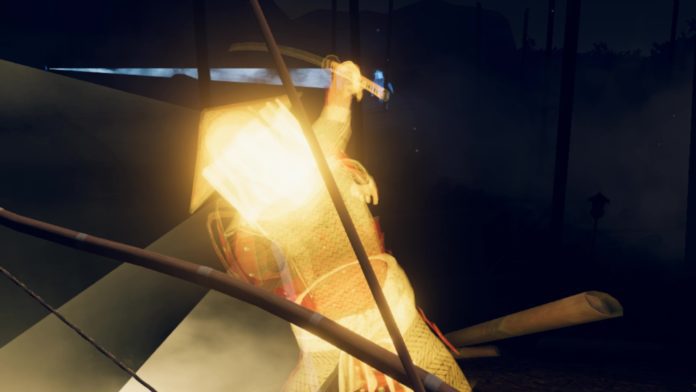The original Holopoint holds a much-vaunted role for me as the game I credit most for proving that VR and fitness are a match made in Heaven. When first I experienced it, I had no notion how physically taxing it would be until I felt my legs the next day, and then still the day after that, and again the day after that, culminating in the finale of my 50 Day VR Fitness Challenge. I even started using a weighted vest to push my limits just a little bit further.
Holopoint helped put me on the path to a VR fitness lifestyle, so when I saw a sequel, Holopoint: Chronicle, released somewhat out of the blue I was excited to see what new leg-hammering indulgences awaited. Let’s find out.
The Home Base
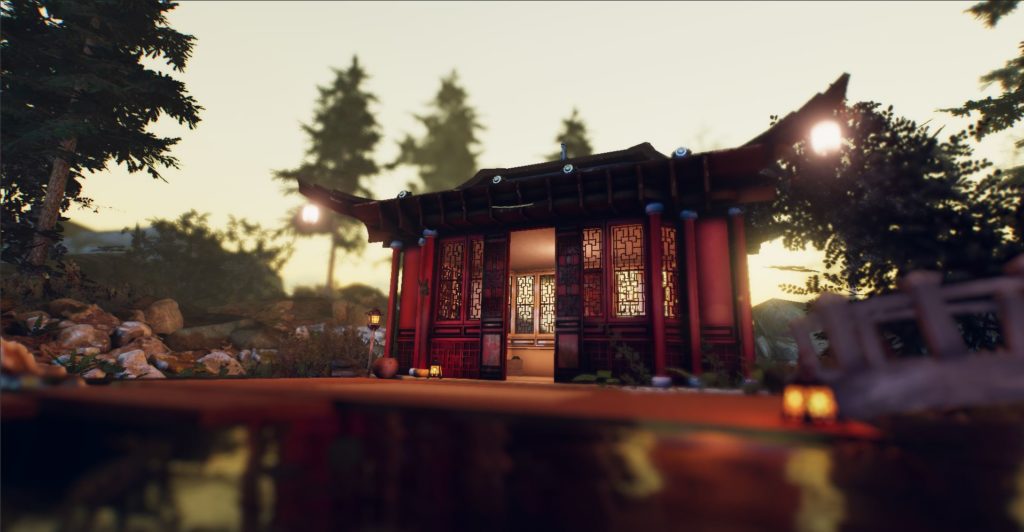
The first place you’ll visit on the HoloPoint ninja training grounds is a hub connecting you to the different training grounds. A 3-dimensional relief map depicts the path you’ll travel from the base to each of the training locations concluding with the fifth location at the top of a volcano.
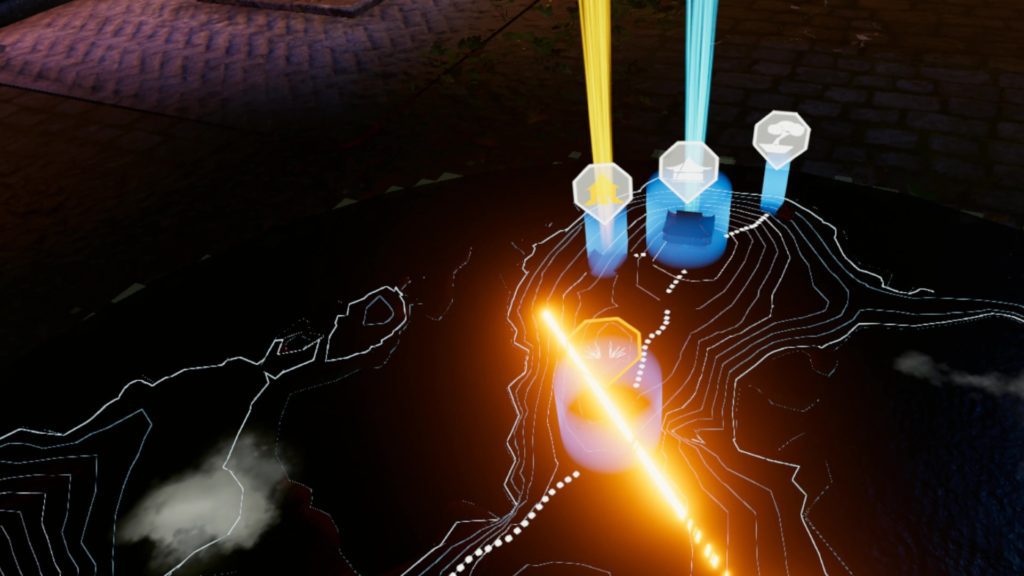
The base location is a beautiful and peaceful setting, replete with lush greenery, bamboo walkways, and gently babbling waterways. This is a nice way to get your mind calm and centered before the cube onslaught that awaits.
Dojo
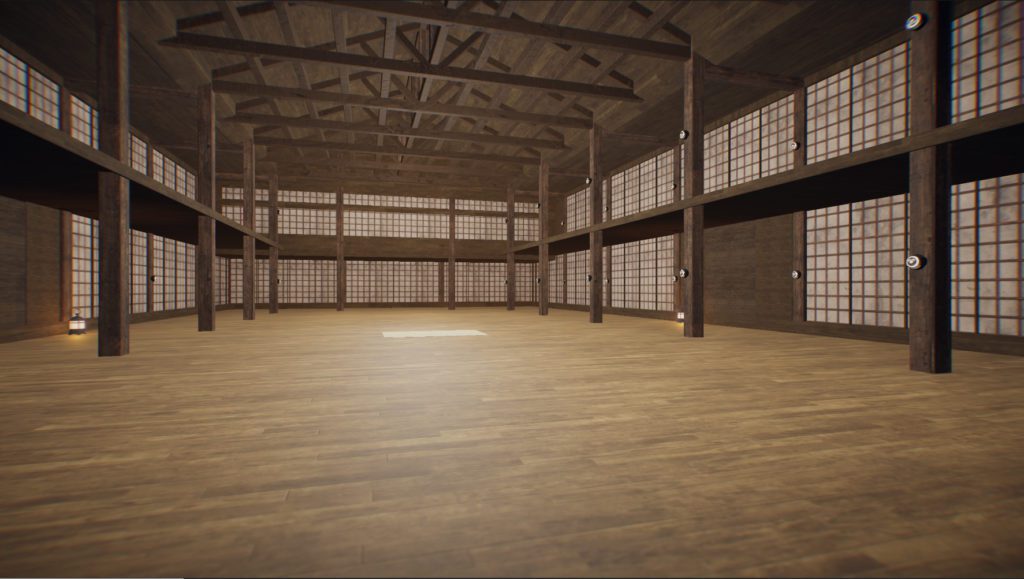
The initial training ground should be familiar to fans of the first title. The original dojo is back but reworked with new details, polished to a high sheen, and with a twist. It begins much the same as the original, with holographic cubes that spawn, hovering, throughout the room that you must target with a well-aimed arrow. Upon hitting one you are rewarded with immediate countermeasures, a fast-moving beam shot directly back at you.
Taking too long to meet your arrow’s mark against the cubes will get you shot at just the same, but without the same anticipation for evasion that landing a good shot provides, making timing the dodges more unpredictable. Two hits during any one wave and your game is over.
Compared to the original, everything feels tighter and faster-paced. Projectile beams are sped up, requiring faster reflexes and precise timing more than ever before.
Dodges can be executed in any number of ways; side-stepping, leaning, squatting, lunging, or jumping are all acceptable, but for the greatest leg workout, squatting and lunging are going to be your bread and butter.
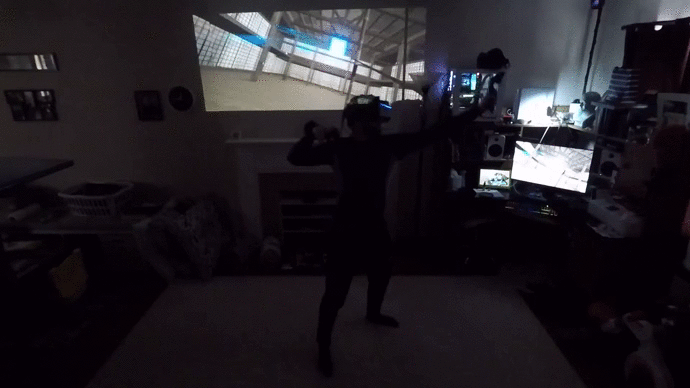
Starting on the first wave, each successive wave brings with it more simultaneous cubes, then in wave five, we are introduced to the first of a new breed of holo-polyhedrons.
These 20-sided cubes demand reflexes that I’ve never encountered in a VR game before. While at first motionless on the floor, hitting it sends the polyhedron rocketing up into the air like popcorn and a follow-up shot must be quickly knocked, loosed, and struck before it can return to the Earth again. You only have about a second, maybe two, to execute this maneuver once it’s begun. Doing so successfully provides a short respite it the constant dodging, but any mistake or lollygagging will be met with another beam to avoid.

The inclusion of the new polyhedranes also provides a different kind of challenge, this one mental. Once accustomed to the rhythm of shooting arrows, hitting targets, and dodging, having a target that sometimes has you dodging, sometimes not, resulted in me at times dodging when I didn’t need to, or worse, not dodging when I should. This requires careful concentration.
To my dismay, occasionally a good shot would have no effect on shattering the cubes and I’d be forced to retarget.
On the fifth wave, you’ll witness a transformation of the dojo as the apparent illusion of the dojo recedes and you see it now has fallen to ruins and lay in shambles, forest outgrowth creeping in. The transformation itself obscures the locations of the cubes and polyhedranes surrounding you and it becomes too easy to be caught unaware.

Village
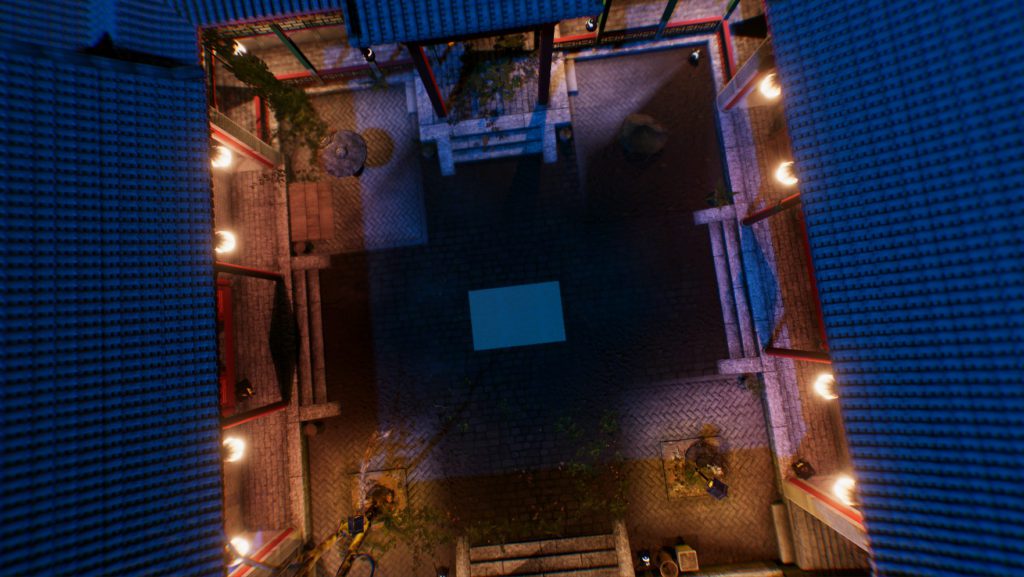
The next training ground that awaits is a garden courtyard. This training simulation is perhaps the most interesting. Starting in the first wave, two cubes spawn simultaneously, joined together by a fuse. Hitting one cube (resulting in an obligatory beam shot back) commences a chain reaction where the fuse from the first cube quickly recedes toward the adjoining cube.
The adjoining cube must then be struck before the fuse can burn all the way down or be shot at if it doesn’t, but so too when you do. As the waves progress more cubes are conjoined and more fuses are set. There is some strategy involved in targeting which cubes will result in the least threatening chain reaction.
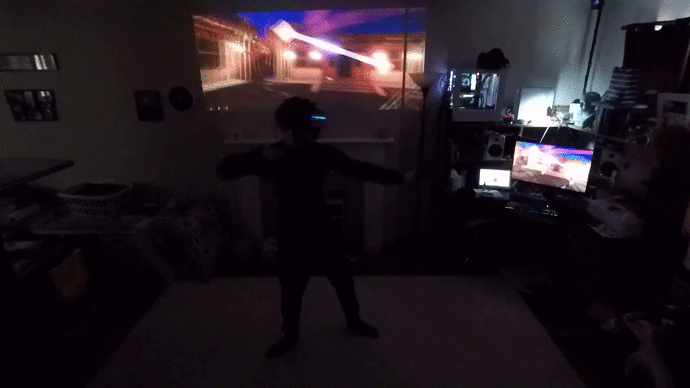
Forest
The third training ground on the path takes you to a lamp-lit bamboo forest at night. The cubes are stretched out into narrower vertical rectangles and the beams that are fired back are likewise fanned out vertically. These offer fewer options for dodging; either side-stepping, leaning, or lunging laterally. The deadly countermeasures feel faster than ever. You’ll need an acute awareness of your real-world surroundings and deft reflexes if you’re to safely dodge with the lightning speed necessary to clear the beams in time.

I found myself frustrated with how one rectangular cube spawned repeatedly behind a bamboo stalk with a lamp at its base. No matter where I stood or how exacting my shot, it would glance away every time, and I’d have to take the hit all while more cubes are firing up around me. This felt like a bug, not a feature.
This stage also apparently features ninjas, though I didn’t progress far enough to encounter them.
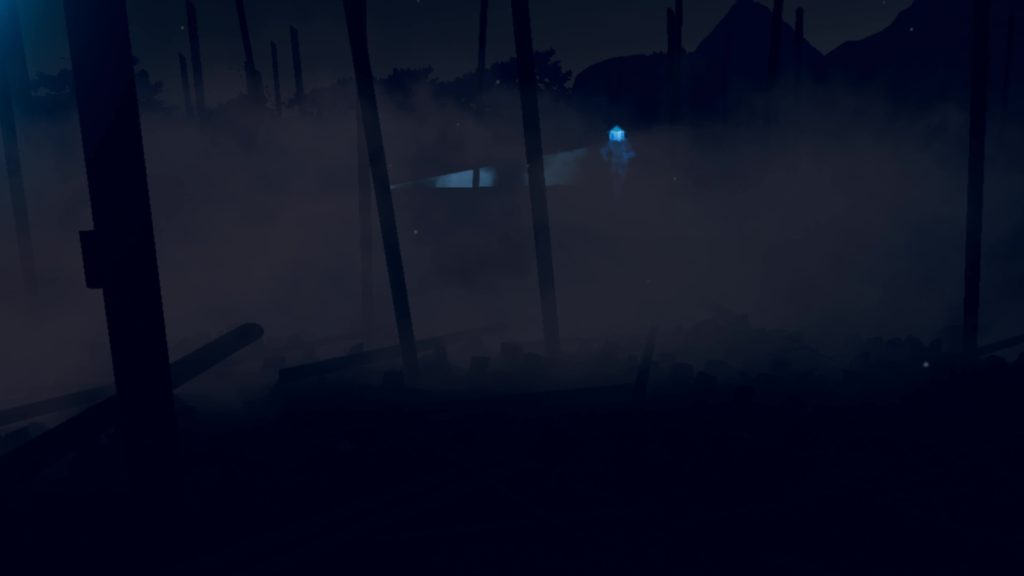
Mountain Top
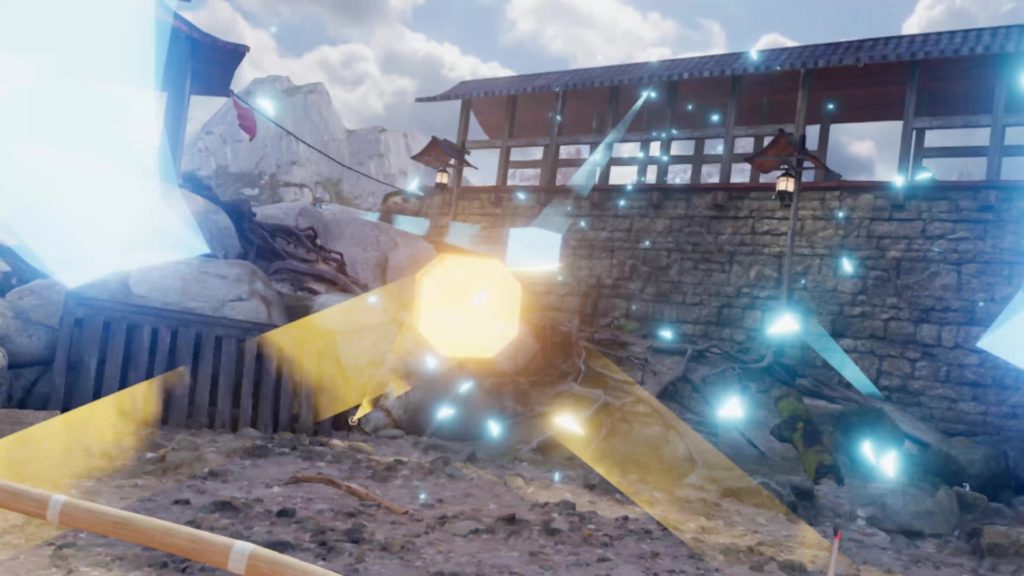
At the summit of the mountain, a beautiful destination set beside a fallen battlement. We’re back to basic cubes again and a new type of polyhedrane, this variety a bit of a head-scratcher. When striking these, the objective is not to dodge, but remain immobile. Instead of having a beam targeted directly at you, you get two beams directed each beside you. Just stand there and feel the breeze as they pass by. In fact, you don’t even have to target them, just ignore them in deference of more threatening encounters, such as the reincarnation of the holo-samurais.
Initially, I was disappointed by the absence of the Samurai warriors, so it was with a fond familiarity of terror that I first glimpsed one sprinting down from the mountain parapet toward me, kamikaze style. Suddenly, I was back in The Lab’s Longbow tower defense game, but instead of being safely sheltered upon a tower battlement I was down on ground level going toe to toe with the invaders, and instead of breaking through a castle gate, they were breaking through me with flying spin kicks.
Volcano
In the final battleground of the game, you’re atop an active volcano with lava churning about you. Not only will you have to face all your foes from earlier stages, but there are several new deadly encounters that you’ll have to contest on your own. I’ll give you one hint: be ready for anything.
Preparation
As always, I paired my Polar H10 chest-strap heart rate monitor with the Polar Beat app. The tried and true cotton bandana on my head and a VRCover pleather foam cover.
Intensity 7/10

- Calories burned: 317
- Calories per minute: 8.6
- Average heart rate: 138
- Max heart rate: 174
- Active Minutes: 37
I’d rate this game as moderate to high intensity. The Dojo training ground had me reach peak intensity, and doing the most squats, followed by The Village and Mountain Top, and with The Forest and Volcano stages being the least intense. Granted, I generally played each stage until failure and so each subsequent stage terminated more promptly than the one before it.
Shoulders 7/10
Keeping both arms raised in this game is no small feat and for many people, this is the first body part they’ll feel fatigue. For the best results, keep your bow arm locked out and straight whilst pulling back as far as you reach the string with your arrow hand, guiding the pull with a raised elbow as if performing a “rise and shine” stretch first thing in the morning. This will give you the greatest range of movement and the most powerful shot.
Legs 9/10
If you’ve committed yourself to squats and lunges, this game simply dominates in hammering the quads and hamstrings. While only a quarter squat depth is necessary to dodge the beams in most cases, full squats will deliver the best results. Not every stage demands the same amount of squat fodder, so this gets a 9 out of 10.
Core and Balance 9/10
Not only is there ample opportunity to squat for days, but leaning, side-stepping, occasionally jumping out of the line of fire is almost just as common. In The Forest, for example, keeping your feet anchored in place while narrowly dodging a bolt as it comes whizzing just by your face, demands strong engagement of the core and careful balance to keep one’s footing.
Time Perception 6/10
In game, there is little time spared for watching the seconds tick by as you’re fully invested in the heat of battle, but load times are agonizingly slow when transitioning among game stages and this greatly detracts from the overall experience. At times, I would wait a full minute or longer for the stage to finish loading.
Replayability 10/10
There is a lot of content here to explore and the huge variety of training grounds and enemy encounters makes for an experience that is never the same twice.
Fitness Scalability 9/10
Depending on the stage and the style of play, the intensity can range from moderate to high. The exertion level for squats and lunges versus side-stepping and leaning is immense, so I suggest committing to whichever method achieves your desired intensity level. Different stages alter the degree of speed and range of movement needed for success.
Lack of Nausea 1/10
Comfort is the weak link by which Chronicle ultimately collapses under its weight. Not only was I unable to achieve acceptable performance from the game, but at the behest of the developers I had “motion smoothing” turned off, which unfortunately made even the gaze stutter, turning the gameplay into a slide show. Occasionally the compositor would pop in, essentially delivering a death sentence.
The original Holopoint looked great on the HTC Vive headset because of the high contrast of the visuals and simplistic environments. Chronicle, on the other hand, while top-notch visually, looks fuzzy and really begs for a higher fidelity headset to enjoy the scenery. In a Pimax 5K+, for example, it was gorgeous.
Somewhat ironically, as the game only lists compatibility with the HTC Vive, I was able to achieve a smoother experience by playing with the Pimax 5K+ headset. Even while experiencing reprojection, the game was much more playable on the 5K+ and I additionally benefitted from the wider field of view and full appreciation of the rich visuals. In fact, it was on the 5K+ that I was able to get on the top 10 leaderboards for the Volcano stage.
Social Competition 6.5/10
HoloPoint: Chronicle begs for a cooperative or competitive multiplayer mode, but there is none to be had here. There are however daily and weekly challenges that take place on a rotating basis in different training grounds, as well as a global leaderboard for each training ground for overall achievement.
I participated in the daily competition at the village level and was again greeted with something new, my favorite holo-baddies, the Ninjas. These were more aligned with the star-throwing ninjas from the first game, but here they were jumping from roof to roof and in and out of doorways, slinging bolts at me when they got close enough. It was fun until they stopped coming, and I was left standing there with my controllers in my pockets, whistling Dixie until I simply had to quit.
VRFI Fit Score 5/10
Holopoint has the potential to be a stellar VR fitness game, but in its current form it is hobbled by dismal performance, long load times, and bugs that make it – at best – a struggle to endure. Despite all this, I still yearn to play more. I hope the developers will continue to improve it, but at this time I cannot recommend it. If circumstances change, this review will be revised to reflect the impact.
The Good
- Superb bow mechanics and handling makes for a realistic archery experience
- Combat is satisfying and varied allowing for a range of play styles and strong replayability
- Beautiful visuals and vivid effects if you have a headset capable of displaying them in all their glory
- Excellent choice of locations for each training ground
- Good variety of community challenges
- An unparalleled workout for the lower body, shoulders, and core
- Nice soundtrack
The Bad
- Terrible performance
- Lacks support for SteamVR motion smoothing
- Long load times
- Game disrupting bugs
Holopoint: Chronicle is available on Steam for HTC Vive headsets priced $18.99

